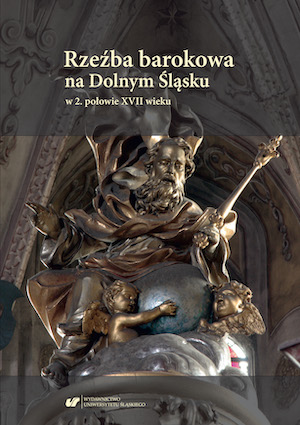Tu es Petrus… Ambona z kolegiaty w Głogowie. Jej dzieje, ikonografia i geneza artystyczna
Tu est Petrus… The pulpit from the Collegiate Church in Głogów. Its history, iconography and artistic origins
Author(s): Jacek Witkowski, Jakub Szajt
Subject(s): Fine Arts / Performing Arts, Visual Arts, History of Art
Published by: Wydawnictwo Uniwersytetu Śląskiego
Summary/Abstract: The pulpit from the Collegiate Church of the Virgin Mary was funded in 1697, where it was to be found until 1945, when it was seriously damaged during the war. Its surviving elements are on display today in the Collegiate Church and the local museum. The pulpit has not been studied extensively despite its high artistic value – the first man to note its visual qualities was an anonymous author of a visitation document drawn up between 1706 and 1711.
The pulpit was made of white marble from Supíkovice and grey marble from Przeworno as well as white painted wood. Grey marble was used to make structural elements and some decorations. Its ideological concept can be found in an inscription placed on the backrest and quoting Christ’s words addressed to St. Peter (Matthew 16:18): “You are Peter (Rock) and on this rock I will build my Church.” The words became the theological and legal basis of the primacy of St. Peter and his papal successors in the universal Church. This was splendidly expressed by the sculptor of the Głogów pulpit, showing Peter as a high priest wearing an ancient-style garments – a tunic and a loose toga. The front of the pulpit featured an expressive carved scene of the Conversion of St. Paul. It conforms to the iconographic tradition, well-established since the Middle Ages and based on an account of the event to be found in the Acts of the Apostles (Acts 9:3-6). Over the lintel with the date of the foundation, there was placed a double cartouche with the coats of arms of the founders of the pulpit. An oval relief with the Annunciation scene was a reference to the Marian dedication of the Collegiate Church in Głogów. The adjacent medallion is filled with the coat of arms of a cleric from the Silesian family of von Lohr, who may have contributed to the foundation of the pulpit. The whole was crowned with a carved wooden group representing Christ surrounded by radiant glory and angels.
The Głogów pulpit is the second known Catholic pulpit in Silesia with a figural support. Despite some references to the Silesian tradition, in its artistic and formal origins it is primarily Netherlandish, more specifically Flemish. What is typical of Netherlandising art is the very material – dark marble in the structural parts and contrasting white marble in the figural decorations. Like in their Netherlandish counterparts, the Głogów artists used local stone deposits. Such double colouring of marble is very characteristic of stone sculptures of the Baroque era in Belgium and Holland, where its tradition goes back to Gothic art. Thus the work may have been created by a Flemish artist or a sculptor well familiar with Flemish models – at the current state of research his name is still unknown, as is that of the main founder of the pulpit.
Book: Rzeźba barokowa na Dolnym Śląsku w 2. połowie XVII wieku
- Page Range: 71-91
- Page Count: 22
- Publication Year: 2020
- Language: Polish
- Content File-PDF

